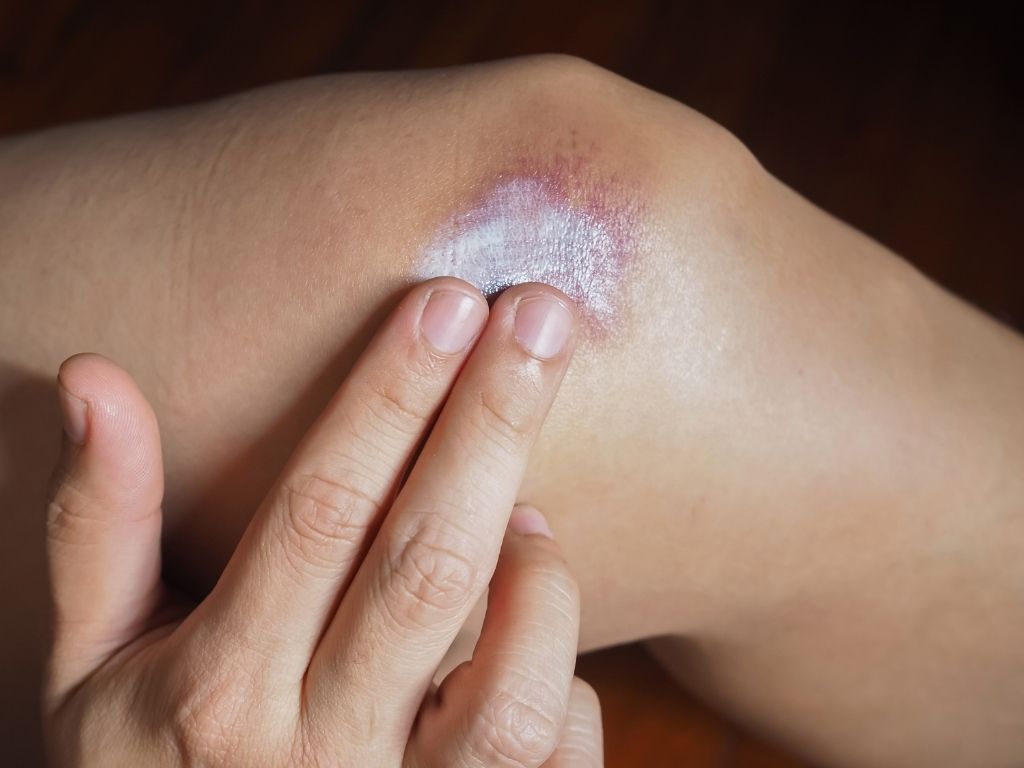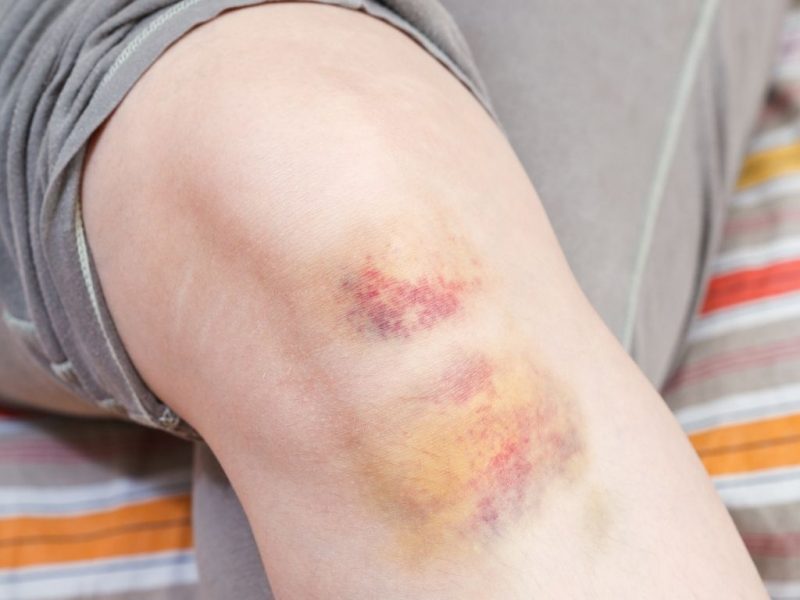You too have stood beside your crying child on the playground or at the kindergarten yard as he was cradling his bruised knee or elbow after a fall. You have also experienced on your own skin how painful a bruise can be. Fortunately, these injuries are usually not severe, you don’t have to rush to the emergency room immediately. Instead, learn how you can treat the injury at home, and what remedies to have for such cases!
You can read in this article about the following topics:
- What are contusions?
- What to do with a contusion?
- Medical supplies to keep at home
- Treating contusions: when to see a doctor?
What are contusions?
What is exactly a contusion? The word expresses it perfectly. It is an injury that most often results from blunt force trauma to a body part. It can be a muscle, a joint, or a bone, like a knee or a skull: the contusion appears in the form of painful swelling. In addition, depending on the type of injury, it may be accompanied by a superficial or deeper wound. The structure of the affected tissue is damaged, especially when it comes to muscles: even bruising can occur around the injury.
There are several types of contusions, depending on which tissues are affected by the injury:
Muscle contusion
The muscle tissue is damaged and haematoma forms in the muscle fibers, which is the cause of the skin discolouration and bruising. The affected area first turns red or blue, then dark purple, and as the healing process progresses, the haematoma is reabsorbed, and the bruise turns yellowish-green. The pain that accompanies the muscle contusion is barely noticeable, it can range from mild tenderness to severe, intense pain, depending on the degree of the tissue damage. In severe cases, muscle contusion can result in partial or complete loss of movement functions in the affected area.
Joint contusion
Haematoma forms in the joints as a result of a joint contusion. It is typically caused by sports injuries, most commonly in the shoulder or knee joints. Contusions are accompanied by severe pain and a limited range of motion in the joints.
Bone contusion
Bone contusions can occur in areas where the bone is covered by a very thin layer of skin, such as the tibia or knee. Since the periosteum is particularly sensitive this injury is usually accompanied by sudden, intense pain, but it passes quickly.
What to do with a contusion?
If there was an accident, and you don’t think it’s necessary to see a doctor, it’s good to know how to treat the injured limb at home. Be sure to soothe the patient, especially if a child gets injured, and take them to a safe place. The best option is to walk them home or take them home.
Resting
The most important thing is to rest the injured limb, keep it elevated and wrap a bandage around it. A cold compress can help reduce swelling and soothe the pain but use it with care and only for a short period of time! This is because icing the injured limb can slow down the healing process. Ten minutes is more than enough, but if it doesn’t seem to help, you can repeat the process once. In case of a muscle injury, only rest the injured limb for a few days, as the muscle won’t be able to fully recover otherwise. So try to move the injured limb, and encourage children to do the same.
Creams
You can apply various creams, ointments, or gels. Pain in the injured muscles is often caused by inflammation, which can be effectively treated by over-the-counter non-steroidal anti-inflammatory creams. It is important to note that you shouldn’t use these creams with occlusive dressings because the skin will absorb too much of the active ingredients. There are also creams that first cool the skin, then heat the skin, and finally relax the injured area.
If you want a gentler treatment, try herbal extracts. Arnica cream is especially useful for treating bruises, but ointments containing horse chestnut or comfrey also help reduce symptoms. Whatever cream you choose, make sure to avoid the eye area or mouth. Also, don’t use these creams on mucous membranes or open wounds.
Treating the wounds
If there is an open wound where the contusion occurred, clean and disinfect the area and treat it according to the severity of the injury. A band-aid is often enough, but you may need a bandage.
Medical supplies to keep at home

When you first encounter a contusion, it can be daunting if you don’t have any supplies to treat the injury. This is especially true for kids, so if you have a kid who is constantly running around, make sure to fill the medicine cabinet with a few basic supplies.
Icing
Always keep ice gel packs in the freezer at home. This versatile tool is not only great for cooling injuries, but when heated in hot water, it’s perfect for relaxing the muscles and easing pain. In both cases, wrap the gel pack in a kitchen towel so it doesn’t come into direct contact with the skin, as there is a risk of ice burns or burns! However, you can use a bag of frozen vegetables or a handful of ice cubes to cool the injured body part, but based on my many years of experience, I vote for the ice gel pack.
Bandaging
In addition to bandages (gauze, gauze dressing, band-aids), always have a roll of elastic bandages at home. Wrap the injured limb and apply light pressure to the contusion and dilated blood vessels, thus improving circulation and stopping the bleeding under the skin. Nowadays, you can buy self-adhesive bandage wraps that are easy to use, so it won’t be a problem to wrap the injured body part at home.
Pain relief, anti-inflammation supplements
You will definitely need some painkillers with different active ingredients. Read the package leaflet, ask your pharmacist how to use these meds or supplements, and buy a few creams as well. Have one for pain relief and for inflammation, but also choose a muscle relaxer and a cream to treat bruises too!
Treating contusions: when to see a doctor?
When an injury occurs, it is not easy to determine what damage it caused at first. In case of a major contusion, or if you’re not sure it’s a contusion, see a doctor! If you can’t move the injured limb, do the same.
Using the above treatment options (resting the injured limb, using a cold compress, pain meds, anti-inflammatory meds) may not help. If the symptoms don’t improve or get worse within a few days, see a doctor!
And most importantly, when your kid injures himself, you have to kiss it and make it better!

